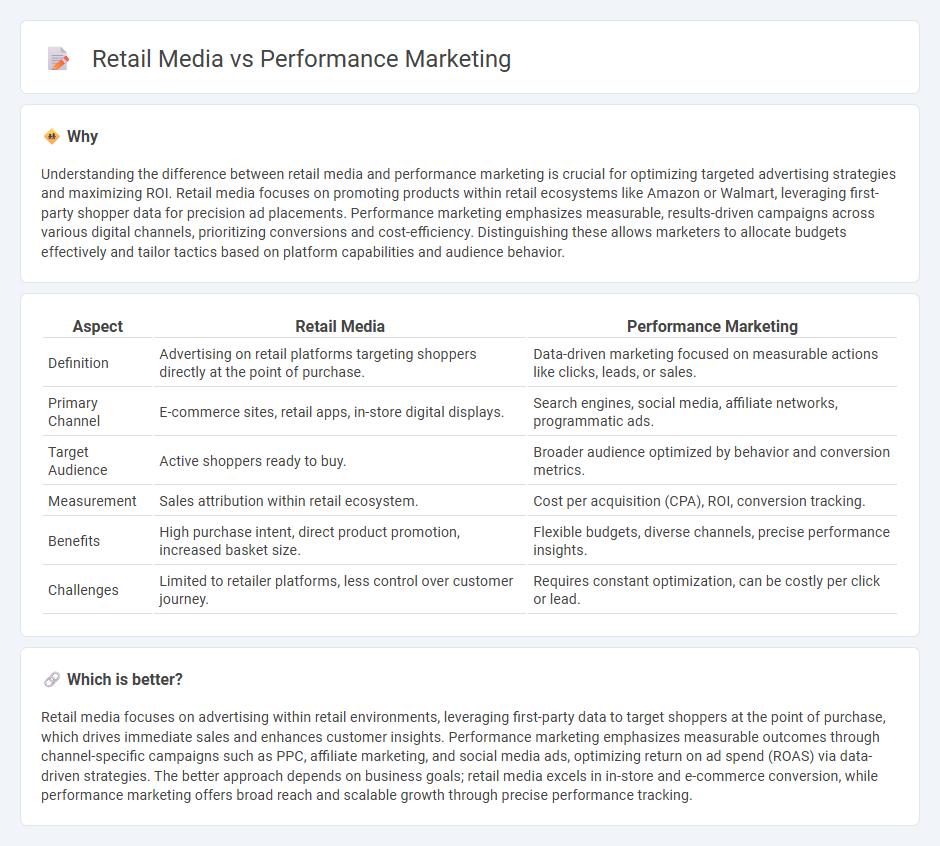
Retail media targets consumers directly at the point of purchase within retailer platforms, leveraging first-party data to drive product visibility and sales. Performance marketing focuses on measurable outcomes like clicks, leads, and conversions across various digital channels to optimize advertising spend. Explore how these strategies differ and complement each other to maximize marketing efficiency.
Why it is important
Understanding the difference between retail media and performance marketing is crucial for optimizing targeted advertising strategies and maximizing ROI. Retail media focuses on promoting products within retail ecosystems like Amazon or Walmart, leveraging first-party shopper data for precision ad placements. Performance marketing emphasizes measurable, results-driven campaigns across various digital channels, prioritizing conversions and cost-efficiency. Distinguishing these allows marketers to allocate budgets effectively and tailor tactics based on platform capabilities and audience behavior.
Comparison Table
| Aspect | Retail Media | Performance Marketing |
|---|---|---|
| Definition | Advertising on retail platforms targeting shoppers directly at the point of purchase. | Data-driven marketing focused on measurable actions like clicks, leads, or sales. |
| Primary Channel | E-commerce sites, retail apps, in-store digital displays. | Search engines, social media, affiliate networks, programmatic ads. |
| Target Audience | Active shoppers ready to buy. | Broader audience optimized by behavior and conversion metrics. |
| Measurement | Sales attribution within retail ecosystem. | Cost per acquisition (CPA), ROI, conversion tracking. |
| Benefits | High purchase intent, direct product promotion, increased basket size. | Flexible budgets, diverse channels, precise performance insights. |
| Challenges | Limited to retailer platforms, less control over customer journey. | Requires constant optimization, can be costly per click or lead. |
Which is better?
Retail media focuses on advertising within retail environments, leveraging first-party data to target shoppers at the point of purchase, which drives immediate sales and enhances customer insights. Performance marketing emphasizes measurable outcomes through channel-specific campaigns such as PPC, affiliate marketing, and social media ads, optimizing return on ad spend (ROAS) via data-driven strategies. The better approach depends on business goals; retail media excels in in-store and e-commerce conversion, while performance marketing offers broad reach and scalable growth through precise performance tracking.
Connection
Retail media and performance marketing are interconnected through their shared focus on measurable consumer engagement and sales outcomes. Retail media leverages data-driven advertising on e-commerce platforms to target shoppers at the point of purchase, enhancing conversion rates. Performance marketing optimizes investments by using metrics such as click-through rates and return on ad spend, creating a feedback loop that refines retail media campaigns for maximum efficiency.
Key Terms
**Performance Marketing:**
Performance marketing leverages data-driven strategies to optimize advertising spend based on measurable outcomes such as clicks, conversions, and return on ad spend (ROAS). It employs channels like paid search, social media ads, and affiliate marketing to target audiences with high precision and track campaign effectiveness in real time. Explore the nuances of performance marketing to boost your digital advertising ROI effectively.
Conversion Tracking
Performance marketing drives measurable results through conversion tracking by optimizing ads based on actions like purchases or sign-ups, leveraging platforms such as Google Ads and Facebook Ads. Retail media focuses heavily on conversion tracking within e-commerce ecosystems, using data from retail sites like Amazon or Walmart to target ads and measure the direct impact on sales. Explore how integrating both strategies can maximize your ROI through precise conversion tracking analytics.
Cost Per Acquisition (CPA)
Performance marketing emphasizes driving targeted customer actions with a strong focus on optimizing Cost Per Acquisition (CPA) by utilizing data-driven strategies across channels like search, social, and affiliate marketing. Retail media leverages retailer-owned digital platforms and first-party data to deliver highly relevant ads directly at the point of purchase, often resulting in lower CPA through enhanced audience targeting and shopping intent. Explore how integrating both approaches can maximize ROI and reduce acquisition costs effectively.
Source and External Links
What Is Performance Marketing? Definition and Beginner's Guide - Performance marketing is a results-driven digital marketing strategy where advertisers pay only when specific measurable actions, such as clicks, leads, or sales, are achieved through channels like PPC, affiliate marketing, and social media advertising.
Performance-based advertising - Performance marketing, also called pay for performance advertising, charges advertisers only when measurable results like acquisitions or sales are completed, distinguishing it from brand marketing which focuses on awareness and opinions.
What is Performance Marketing, & How Does it Work? - This strategy allows businesses to optimize their ad spend and track ROI by paying for specific completed actions, enabling real-time adjustments to improve short-term results like clicks, leads, and sales, in contrast to brand marketing's focus on emotional connection and long-term loyalty.
 dowidth.com
dowidth.com